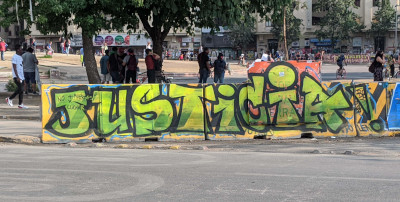Free Law Project Participates in Chilean Judicial Modernization Initiative

Last week, as executive director of Free Law Project, I had the privilege of traveling to Santiago, Chile to participate in their conference on "Electronic Processing of Justice." The conference was convened by the Chilean judiciary with the goal of comparing and contrasting judicial modernization efforts across jurisdictions.
Although the conference was shortened due to the ongoing unrest in Chile, over a two day period I was able to share my experiences with electronic court systems in America and with government software development generally.This was the first time that Free Law Project was invited by another country to help with their modernization efforts, and I was proud to represent the organization.
In my presentation, [I made several suggestions to the Chilean judiciary(pdf)][pdf], with the goal of answering the question, "What actions or techniques would make a judicial technology initiative successful?"
Here's what I proposed:
-
Focus on openness of the system, with open source code, an open development process, an open feedback loop from stakeholders and the public, open data standards, and open data models.
-
Whenever possible, provide bulk data, APIs, and full - text search so that the public can engage with the system, and an ecosystem of organizations can innovate around it.Both bulk data and APIs serve important goals.While APIs can help you get a pariticular piece of data, bulk data allows innovators or researchers complete freedom of innovation.
-
Create hooks in eFiling systems for add - on automation that can check for things like privacy violations, [export controlled technology][export], party names, [readability scores][read], etc.
-
Consider tools like [Docassemble][da] for simple online forms.
-
Have a vulnerability disclosure policy, bug bounty program, and regular security audits.
-
Use agile development methodologies and user - centered design.Where possible, consider funding technology initiatives as [services, not purchases][service - not - purchase].
-
Engage the public through innovation grants, hackathons, or the facilitation or creation of independent organizations that can help organize information.
-
Avoid: Publisher lock - in, [the California - Deloitte disaster][ca], and the latest tech trends like machine learning and AI.
Presenting on this topic is challenging & mdash; How do you decide which topics are important to a project & mdash; but I'm hopeful that by presenting broadly on software development methodology, procurement, and ecosystem development, the topics I shared will prove valuable to their future initiatives. I welcome feedback on this list.
Over the next few years, it appears Chile will face many challenges.Income inequality has reached a breaking point, causing ongoing unrest across much of the country, and trust in the government is dangerously low.So far, the judicial branch in Chile has remained outside these crises, and my hope is that as the judicial branch modernizes, it will continue to make itself fair, efficient, trusted, and transparent.
Electronic systems are only a small part of what makes a good judicial branch, but with the right investments, they can help foster transparency, trust, and good governance.
[read] https://en.wikipedia.org/wiki/Flesch%E2%80%93Kincaid_readability_tests [export] https://www.everycrsreport.com/reports/R41916.html [pdf]: /pdf/chile - modernization.pdf [service - not - purchase]: https://18f.gsa.gov/2019/08/20/an-agile-software-development-solicitation-guide/ [da]: https://docassemble.org/ [ca]: https://www.zdnet.com/article/california-abandons-2-billion-court-management-system/